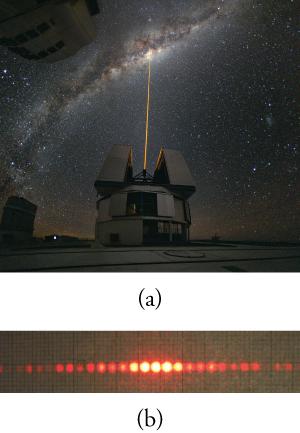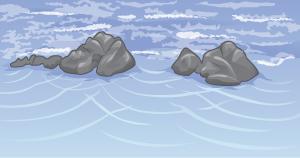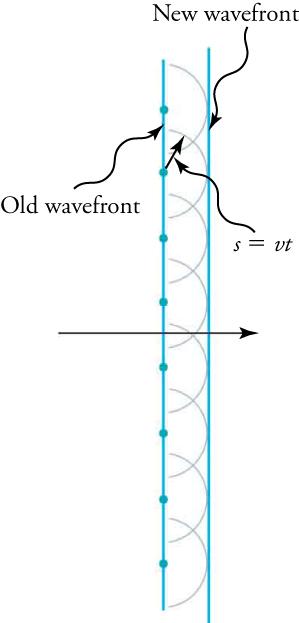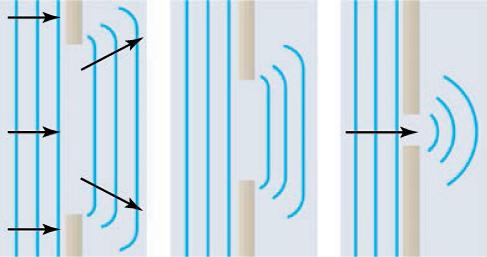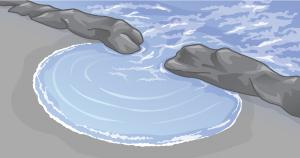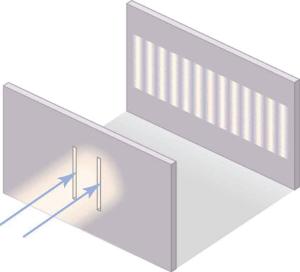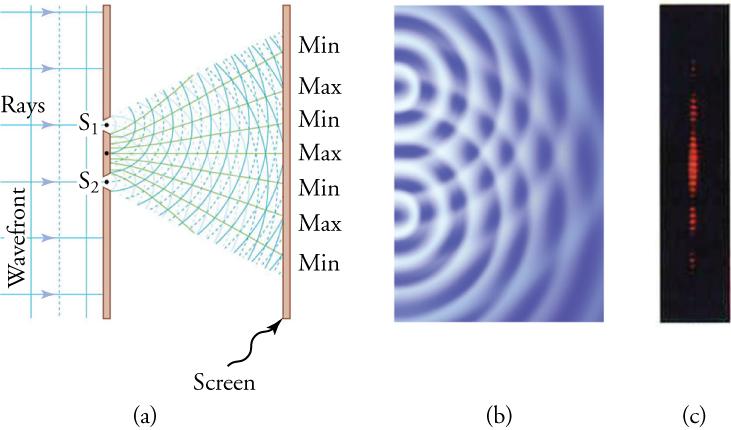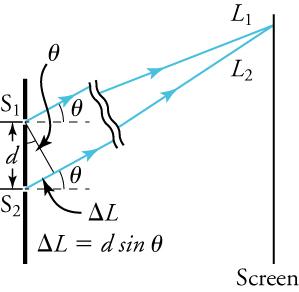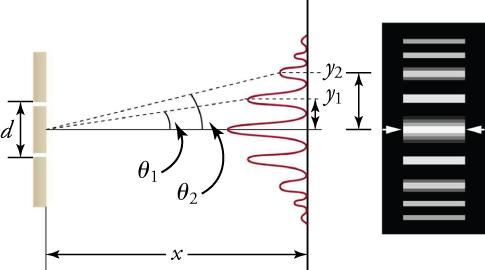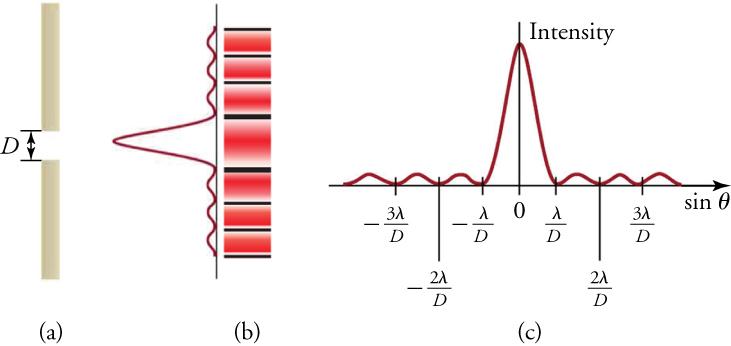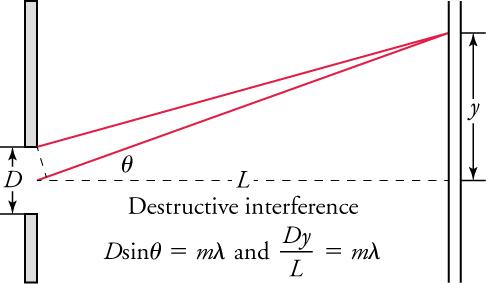Calculations Involving Diffraction and Interference
The fact that the wavelength of light of one color, or monochromatic light, can be calculated from its two-slit diffraction pattern in Young’s experiments supports the conclusion that light has wave properties. To understand the basis of such calculations, consider how two waves travel from the slits to the screen. Each slit is a different distance from a given point on the screen. Thus different numbers of wavelengths fit into each path. Waves start out from the slits in phase (crest to crest), but they will end up out of phase (crest to trough) at the screen if the paths differ in length by half a wavelength, interfering destructively. If the paths differ by a whole wavelength, then the waves arrive in phase (crest to crest) at the screen, interfering constructively. More generally, if the paths taken by the two waves differ by any half-integral number of wavelengths , then destructive interference occurs. Similarly, if the paths taken by the two waves differ by any integral number of wavelengths , then constructive interference occurs.
Figure 17.10 shows how to determine the path-length difference for waves traveling from two slits to a common point on a screen. If the screen is a large distance away compared with the distance between the slits, then the angle between the path and a line from the slits perpendicular to the screen (see the figure) is nearly the same for each path. That approximation and simple trigonometry show the length difference, , to be , where d is the distance between the slits,
To obtain constructive interference for a double slit, the path-length difference must be an integral multiple of the wavelength, or
Similarly, to obtain destructive interference for a double slit, the path-length difference must be a half-integral multiple of the wavelength, or
The number m is the order of the interference. For example, m = 4 is fourth-order interference.
Figure 17.11 shows how the intensity of the bands of constructive interference decreases with increasing angle.
Light passing through a single slit forms a diffraction pattern somewhat different from that formed by double slits. Figure 17.12 shows a single-slit diffraction pattern. Note that the central maximum is larger than those on either side, and that the intensity decreases rapidly on either side.
The analysis of single-slit diffraction is illustrated in Figure 17.13. Assuming the screen is very far away compared with the size of the slit, rays heading toward a common destination are nearly parallel. That approximation allows a series of trigonometric operations that result in the equations for the minima produced by destructive interference.
or
When rays travel straight ahead, they remain in phase and a central maximum is obtained. However, when rays travel at an angle relative to the original direction of the beam, each ray travels a different distance to the screen, and they can arrive in or out of phase. Thus, a ray from the center travels a distance farther than the ray from the top edge of the slit, they arrive out of phase, and they interfere destructively. Similarly, for every ray between the top and the center of the slit, there is a ray between the center and the bottom of the slit that travels a distance farther to the common point on the screen, and so interferes destructively. Symmetrically, there will be another minimum at the same angle below the direct ray.
Below we summarize the equations needed for the calculations to follow.
The speed of light in a vacuum, c, the wavelength of the light, , and its frequency, f, are related as follows.
The wavelength of light in a medium, , compared to its wavelength in a vacuum, , is given by
17.1
To calculate the positions of constructive interference for a double slit, the path-length difference must be an integral multiple, m, of the wavelength.
where d is the distance between the slits and is the angle between a line from the slits to the maximum and a line perpendicular to the barrier in which the slits are located. To calculate the positions of destructive interference for a double slit, the path-length difference must be a half-integral multiple of the wavelength:
For a single-slit diffraction pattern, the width of the slit, D, the distance of the first (m = 1) destructive interference minimum, y, the distance from the slit to the screen, L, and the wavelength, , are given by
Also, for single-slit diffraction,
where is the angle between a line from the slit to the minimum and a line perpendicular to the screen, and m is the order of the minimum.
Worked Example
Two-Slit Interference
Suppose you pass light from a He-Ne laser through two slits separated by 0.0100 mm, and you find that the third bright line on a screen is formed at an angle of 10.95º relative to the incident beam. What is the wavelength of the light?
STRATEGY
The third bright line is due to third-order constructive interference, which means that m = 3. You are given d = 0.0100 mm and = 10.95º. The wavelength can thus be found using the equation for constructive interference.
Solution
The equation is . Solving for the wavelength, , gives
17.2
Substituting known values yields
17.3 Discussion
To three digits, 633 nm is the wavelength of light emitted by the common He-Ne laser. Not by coincidence, this red color is similar to that emitted by neon lights. More important, however, is the fact that interference patterns can be used to measure wavelength. Young did that for visible wavelengths. His analytical technique is still widely used to measure electromagnetic spectra. For a given order, the angle for constructive interference increases with , so spectra (measurements of intensity versus wavelength) can be obtained.
Worked Example
Single-Slit Diffraction
Visible light of wavelength 550 nm falls on a single slit and produces its second diffraction minimum at an angle of 45.0° relative to the incident direction of the light. What is the width of the slit?
STRATEGY
From the given information, and assuming the screen is far away from the slit, you can use the equation to find D.
Solution
Quantities given are = 550 nm, m = 2, and = 45.0°. Solving the equation for D and substituting known values gives
17.4 Discussion
You see that the slit is narrow (it is only a few times greater than the wavelength of light). That is consistent with the fact that light must interact with an object comparable in size to its wavelength in order to exhibit significant wave effects, such as this single-slit diffraction pattern.

